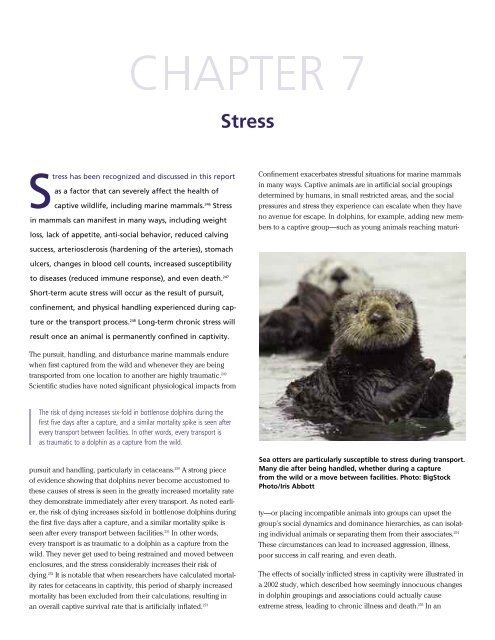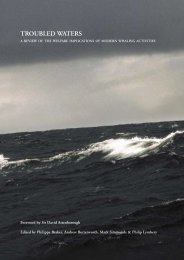The Case against Marine Mammals in Captivity - The Humane ...
The Case against Marine Mammals in Captivity - The Humane ...
The Case against Marine Mammals in Captivity - The Humane ...
- No tags were found...
You also want an ePaper? Increase the reach of your titles
YUMPU automatically turns print PDFs into web optimized ePapers that Google loves.
StressStress has been recognized and discussed <strong>in</strong> this reportas a factor that can severely affect the health ofcaptive wildlife, <strong>in</strong>clud<strong>in</strong>g mar<strong>in</strong>e mammals. 246 Stress<strong>in</strong> mammals can manifest <strong>in</strong> many ways, <strong>in</strong>clud<strong>in</strong>g weightloss, lack of appetite, anti-social behavior, reduced calv<strong>in</strong>gsuccess, arteriosclerosis (harden<strong>in</strong>g of the arteries), stomachulcers, changes <strong>in</strong> blood cell counts, <strong>in</strong>creased susceptibilityto diseases (reduced immune response), and even death. 247Short-term acute stress will occur as the result of pursuit,conf<strong>in</strong>ement, and physical handl<strong>in</strong>g experienced dur<strong>in</strong>g captureor the transport process. 248 Long-term chronic stress willresult once an animal is permanently conf<strong>in</strong>ed <strong>in</strong> captivity.<strong>The</strong> pursuit, handl<strong>in</strong>g, and disturbance mar<strong>in</strong>e mammals endurewhen first captured from the wild and whenever they are be<strong>in</strong>gtransported from one location to another are highly traumatic. 249Scientific studies have noted significant physiological impacts from<strong>The</strong> risk of dy<strong>in</strong>g <strong>in</strong>creases six-fold <strong>in</strong> bottlenose dolph<strong>in</strong>s dur<strong>in</strong>g thefirst five days after a capture, and a similar mortality spike is seen afterevery transport between facilities. In other words, every transport isas traumatic to a dolph<strong>in</strong> as a capture from the wild.pursuit and handl<strong>in</strong>g, particularly <strong>in</strong> cetaceans. 250 A strong pieceof evidence show<strong>in</strong>g that dolph<strong>in</strong>s never become accustomed tothese causes of stress is seen <strong>in</strong> the greatly <strong>in</strong>creased mortality ratethey demonstrate immediately after every transport. As noted earlier,the risk of dy<strong>in</strong>g <strong>in</strong>creases six-fold <strong>in</strong> bottlenose dolph<strong>in</strong>s dur<strong>in</strong>gthe first five days after a capture, and a similar mortality spike isseen after every transport between facilities. 251 In other words,every transport is as traumatic to a dolph<strong>in</strong> as a capture from thewild. <strong>The</strong>y never get used to be<strong>in</strong>g restra<strong>in</strong>ed and moved betweenenclosures, and the stress considerably <strong>in</strong>creases their risk ofdy<strong>in</strong>g. 252 It is notable that when researchers have calculated mortalityrates for cetaceans <strong>in</strong> captivity, this period of sharply <strong>in</strong>creasedmortality has been excluded from their calculations, result<strong>in</strong>g <strong>in</strong>an overall captive survival rate that is artificially <strong>in</strong>flated. 253Sea otters are particularly susceptible to stress dur<strong>in</strong>g transport.Many die after be<strong>in</strong>g handled, whether dur<strong>in</strong>g a capturefrom the wild or a move between facilities. Photo: BigStockPhoto/Iris AbbottConf<strong>in</strong>ement exacerbates stressful situations for mar<strong>in</strong>e mammals<strong>in</strong> many ways. Captive animals are <strong>in</strong> artificial social group<strong>in</strong>gsdeterm<strong>in</strong>ed by humans, <strong>in</strong> small restricted areas, and the socialpressures and stress they experience can escalate when they haveno avenue for escape. In dolph<strong>in</strong>s, for example, add<strong>in</strong>g new membersto a captive group—such as young animals reach<strong>in</strong>g maturity—orplac<strong>in</strong>g <strong>in</strong>compatible animals <strong>in</strong>to groups can upset thegroup’s social dynamics and dom<strong>in</strong>ance hierarchies, as can isolat<strong>in</strong>g<strong>in</strong>dividual animals or separat<strong>in</strong>g them from their associates. 254<strong>The</strong>se circumstances can lead to <strong>in</strong>creased aggression, illness,poor success <strong>in</strong> calf rear<strong>in</strong>g, and even death.<strong>The</strong> effects of socially <strong>in</strong>flicted stress <strong>in</strong> captivity were illustrated <strong>in</strong>a 2002 study, which described how seem<strong>in</strong>gly <strong>in</strong>nocuous changes<strong>in</strong> dolph<strong>in</strong> group<strong>in</strong>gs and associations could actually causeextreme stress, lead<strong>in</strong>g to chronic illness and death. 255 In an
















